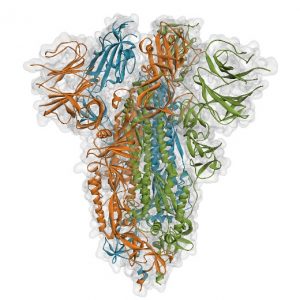Severe Acute Respiratory Syndrome coronavirus 2 (SARS-CoV-2) is a novel coronavirus that triggers coronavirus disease 2019 (COVID-19). This latest SARS disease was first identified during an outbreak of respiratory illness cases in Wuhan City, Hubei Province, China. The World Health Organization first declared this to be a global health emergency in January 2020. In March, COVID-19 rocketed to a global pandemic—the first such designation since 2009’s H1N1 influenza pandemic.
As of mid-March 2020, global confirmed cases of COVID-19 have surpassed 184,000 with over 7,400 deaths worldwide.1 While there are fewer new cases in China, containment efforts have so far failed to reduce the rate of reported cases in many countries. The virus is continuing its global spread with the distinct possibility of becoming a new endemic coronavirus within the human population.2
Coronaviruses Past and Present
The SARS-CoV-2 virus is a member of the Coronaviridae family of viruses containing a single-stranded positive-sense RNA genome encapsulated within a membrane envelope. The coronavirus name is derived from the Latin corona, meaning crown, because the viral envelope when viewed under electron microscopy appears crown-like due to small bulbous projections formed by the viral spike glycoprotein. These glycoproteins only bind to certain receptors on the host cell and are essential for both host specificity and viral infectivity.
Coronaviruses cause illness ranging from the common cold to more severe diseases such as Middle East Respiratory Syndrome (MERS-CoV) and Severe Acute Respiratory Syndrome (SARS-CoV). SARS-CoV-2 shares significant sequence homology with MERS-CoV and SARS-CoV. Researchers can leverage previous research and experience with these two lethal coronaviruses to learn more about SARS-CoV-2.
Obviously, science will play a critical role in helping researchers to better understand, contain and mitigate this perplexing new disease.
Multifaceted Approaches to Tackling SARS-CoV-2
The rapid spread of the SARS-CoV-2 virus and the growing number of deaths have catalyzed an unprecedented response by our medical and scientific communities to tackle the COVID-19 disease—from understanding its epidemiology to resolving its molecular structures, understanding the mechanisms of its druggable protein targets, identifying effective therapeutic agents and developing vaccines to prevent further viral spread.
Identifying key protein targets for drug development is one of the first tasks to be addressed. It is often the case that a specific protein does not yet contain an experimentally determined structure, and researchers must perform homology modeling to gain structural insight into the protein. Homology modeling involves threading one or more existing protein structures that are similar to the protein sequence required for modeling. Even when we use experimental methods such as X-ray crystallography and nuclear magnetic resonance spectroscopy to predict the atomic-level structures of proteins, these structures often lack information that must be found using molecular modeling.
Once a druggable protein model or structure is available, numerous molecular modeling methods allow us to identify drugs with high specificity and efficacy. While these methods include de novo design strategies, the urgency of the current situation makes drug repurposing one of the most economic and efficient therapeutic strategies to pursue. We can also leverage our vast reservoir of knowledge about agents currently known to be effective against other RNA viruses including SARS-CoV, MERS-CoV, influenza and Ebola. Virtual screening methods including docking and pharmacophore modeling are ideal to identify and rank-prioritize lead candidates for further investigation and possible optimization.
While small molecules will likely be the first therapeutics to market, there is also an urgent need for biotherapeutics such as vaccines that trigger the human immune response to protect against COVID-19. These strategies would focus on specifically targeting B and T cell epitope regions that could generate protective immunity while also being resistant to continuing virus evolution.
Accelerating Innovation with In Silico Modeling and Simulation

Relying on physical experimentation alone is not economically sustainable in today’s rapidly evolving COVID-19 environment. Scientists need a deeper understanding of both how and why potential antiviral therapies and vaccines will perform against COVID-19, and they need it today. As an active supporter of the scientific community that is collaborating today on COVID-19 solutions, BIOVIA, Dassault Systèmes develops BIOVIA Discovery Studio.
This world-class life sciences modeling and simulation environment brings together over 30 years of peer-reviewed research and world-class in silico technique. It provides researchers with a complete toolset for use from target identification through lead optimization including tools for biologics design and analysis, classical simulations, structure- and fragment-based design, virtual ligand screening, as well as ADME and toxicity prediction.
As part of Dassault Systèmes’ corporate social responsibility, BIOVIA Dassault Systèmes is pleased to offer academic research groups involved in SARS-CoV-2 related studies a no-charge, six-month license to BIOVIA Discovery Studio to assist them in the search for rapid, safe and effective therapeutic drug candidates against the SARS-CoV-2 virus. If you are an academic researcher in this field, please visit to request a software license and download. This offer will run through June 30, 2020.
Follow BIOVIA on LinkedIn for upcoming blog posts on other topics pertaining to BIOVIA Discovery Studio’s usefulness in COVID-19 research including structural modeling and refinement, protein structure determination with homology modeling, virtual screening/drug repurposing and pharmacophore modeling for lead identification.
1 https://www.bloomberg.com/graphics/2020-wuhan-novel-coronavirus-outbreak/
2 https://science.sciencemag.org/content/early/2020/03/13/science.abb3221

